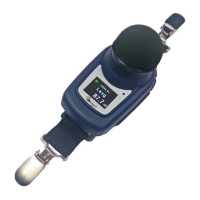May 2015 Page 44 of 51
17. Noise Measurements – A Simple Analogy
In order to try and help explain some of the above concepts, an analogy can be used.
Taking a possible requirement of 100% noise dose equates to 90 dB for 8 hours (this is a
TWA(8h) of 90 dB), this could be considered as running water from a tap. The sound level
can be considered to be how fast the water is running from the tap. If this water is collected
in a container, then this can be equated to the noise dose. So, using this analogy, running
the water at a flow rate of 10 litres per hour for a duration of 8 hours will result in 80 litres of
water being collected. Therefore, a volume of 80 litres equates to 100% dose.
If the water was run at the same flow rate but only for 4 hours, it can be seen that only 40
litres would be collected. This would result in 50% dose. This would mean that if a worker
was exposed to a noise of 90 dB but only for 4 hours then they would receive 50% noise
dose. This is a TWA(8h) of 85 dB (NOTE the TWA(8h) figure is not halved due to sound
being logarithmic; as the exchange rate used in this example is 5 dB this means that
doubling or halving the energy will cause a 5 dB increase or decrease).
Likewise, if the water was run at the same flow rate for 16 hours then 160 litres would be
collected. This results in 200% dose (and a TWA(8h) value of 95 dB).
The length of time that the water is run for is effectively the working shift. Therefore, a shift
duration of something other than 8 hours would mean that the flow rate of the water (i.e. the
sound level) would have to change to ensure that 80 litres of water is collected by the end of
the working shift (to represent 100% dose).
If the flow rate of the water was now 20 litres per hour, then it would only take 4 hours to
collect the full 80 litres. This means that if the average sound level was 95 dB then a worker
could only be exposed to this sound for 4 hours, at which point they would then have been
exposed to 100% of their allowable noise dose.
The dose can be thought of as taking the total volume of water collected over the
measurement duration and comparing it to the total volume which is allowable. In terms of
noise, dose is the total amount of noise energy that a worker is exposed to in comparison to
a defined allowable limit.
The TWA(8h) figure can be thought of as taking the total volume collected and then
calculating what flow rate would be required such that the same volume of water would be
collected if the tap had been running for 8 hours. In noise terms, TWA(8h) is the average
sound which after 8 hours gives the same amount of noise energy that a worker is exposed
to during their working shift.
This analogy can be extended to cover the concept of projected values.
If the water was run at a flow rate of 5 litres per hour for a duration of 5 hours, then 25 litres
would have been collected. If it is then assumed that the water is run at the same flow rate
for another 2 hours then this would suggest that an additional 10 litres will be collected. The
first 5 hours can be thought of as being the measurement duration. The total duration (5 + 2
hours) of 7 hours can be thought of as being the working shift duration. Therefore, a
projected total of 35 litres can be derived. This is effectively measuring the volume of water
for a certain duration (5 hours) and then assuming that the flow rate of the water (that would
give this volume in that time) has been occurring for the entire working shift (7 hours).
Once the projected volume is known (in this case 35 litres) this value can then be normalised
to the 8 hour duration. This is the same as saying what flow rate would be required to collect
the same volume (35 litres) in 8 hours (as opposed to the 7 hours of the working shift).

